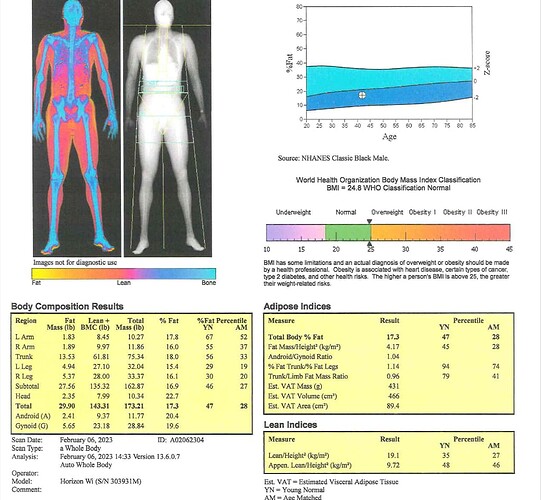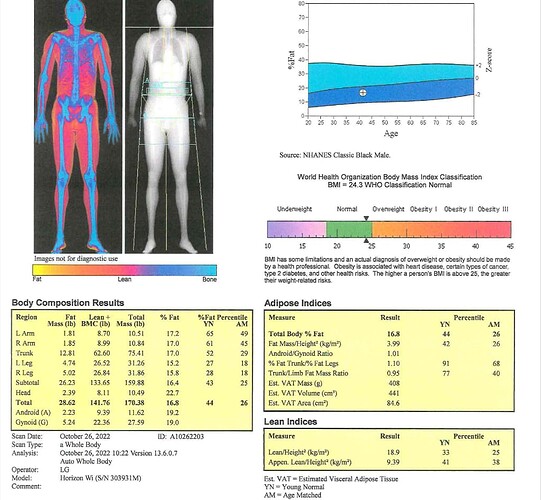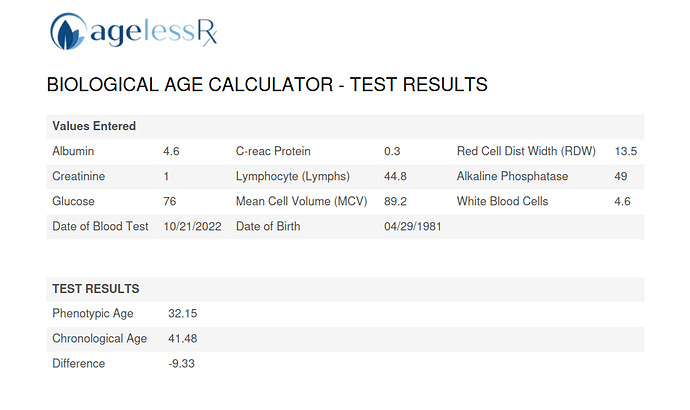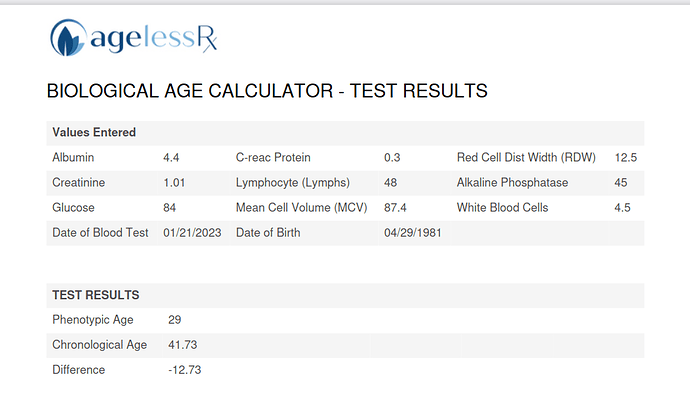I’m posting this so I can relate the effects of my rapamycin usage over 3 months, from October 2022 to January 2023. First, a little about me:
- I’m 41, male, black.
- I exercise 5 times a week, averaging 45 minutes per session. I do 2 sessions of weight lifting (5x5 stronglifts), and 3 sessions of cardio (steps machine, rowing) where I mostly stay under 70% of max hear rate.
- The medication I’m currently taking are: statins (10 mg/day), vitamin D (50k IU/week), B12 (3500mg/day), Omega 3 (2200 mg/day)
I signed up for the rapamycin protocol on HealthSpan, which includes a 3-month supply of rapamycin and acarbose. Based on my labs, I was given a prescription of 4 mg/week of rapamycin, and 25mg of acabose/day, to be taken with food.
Here are the test I decided to use to track health:
- complete blood panel
- lipid panel
- apoB particle count
- insulin level
For fitness, I decided to track:
- muscles fitness via a DEXA scan
- cardiovascular fitness via a device that measures pulse wave velocity on your finger
- cardiovascular fitness via resting heart rate
Blood and lipid panel results
Here are my blood labs for October
blood-work.pdf (61.5 KB)
Some observations from the blood work data:
- rapamycin doesnt seem to improve or worsen my apoB. I’m not surprised by that, statins have worked great for me
- my trigliceride numbers improved noticeably from 47 to 39 mg/dL. Maybe rapamycin is playing a role there?
- my insuling levels are down to their lowest, at 2.3 uIU/mL, this is just confirmtation that I’m indeed taking rapamycin. Tests of insulin levels can be used as a cheaper way to test your rapamycin, BTW.
The rest of the numbers don’t jump out at me, but maybe I’ve missed something. If you guys have see any changes that jump out to you, please let me know
Fitness results
In terms of cardio fitness, I haven’t found a trend to point to. My resting heart rate has been 52-53 bpm during that period. My pulse wave velocity has been around 7.5 and 9, with no clear trend either way.
For muscle fitness, my DEXA scans are below
February 2023:
vs October 2022:
To sumarize the differences:
- total body fast went from 16.8% to 17.3%
- I gained ~3 pounds in that time period
- 1.28 of it was fat
- 1.45 of it was lean mass
This is not bad, and should assuage my fear of not being able to put on lean mass.
Side effects
I tried to be document any side effects that I encountered during that period in a spreadsheet. Here they are:
And finally, just because I’m curious, let’s see what a crude biological age calculator says. These numbers on october 2022:
And these are the results with my most recent blood panels (february 2023):
So apparently a 3-month treatment of 4mg/week of rapamycin and 25mg/day acarbose shaved off 3 additional years off my phenotypic age. I don’t put much stock in these biologcial age calculators, but hopefully they’re “consistently wrong”: the delta/magnitude of change might be wrong, but the direction of the change could be useful to look at over time.
So my conclusions are:
- this dose of rapamycin doesn’t seem to worsen overall lipid levels, given the other medication that I’m also taking (statins, vitamin D, etc). This was important to me, since I don’t consider a significantly higher LDL/apoB level an acceptable tradeoff of taking rapamycin.
- tracking cardiovascular changes didn’t give me much insight over that time period.
- muscular fitness was a mixed bag: I gained weight but overalll gained more muscle mass than fat mass
- Incidentally, I don’t know how normal it is to add 1lbs of lean tissue over 3 months, lifting 2 times a week.




